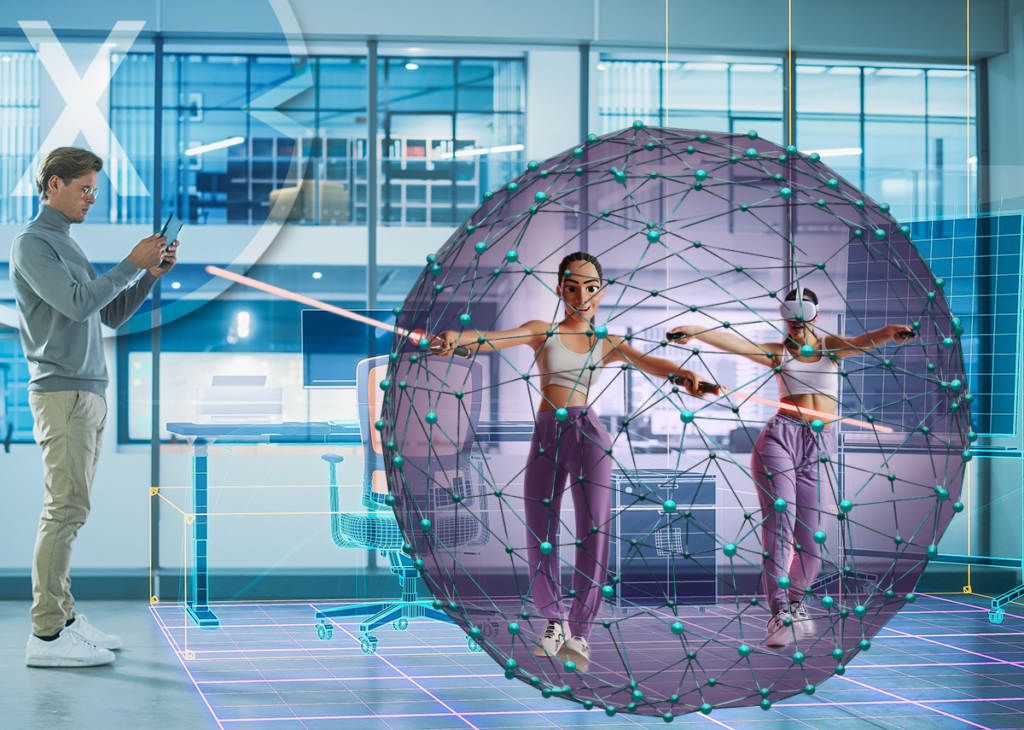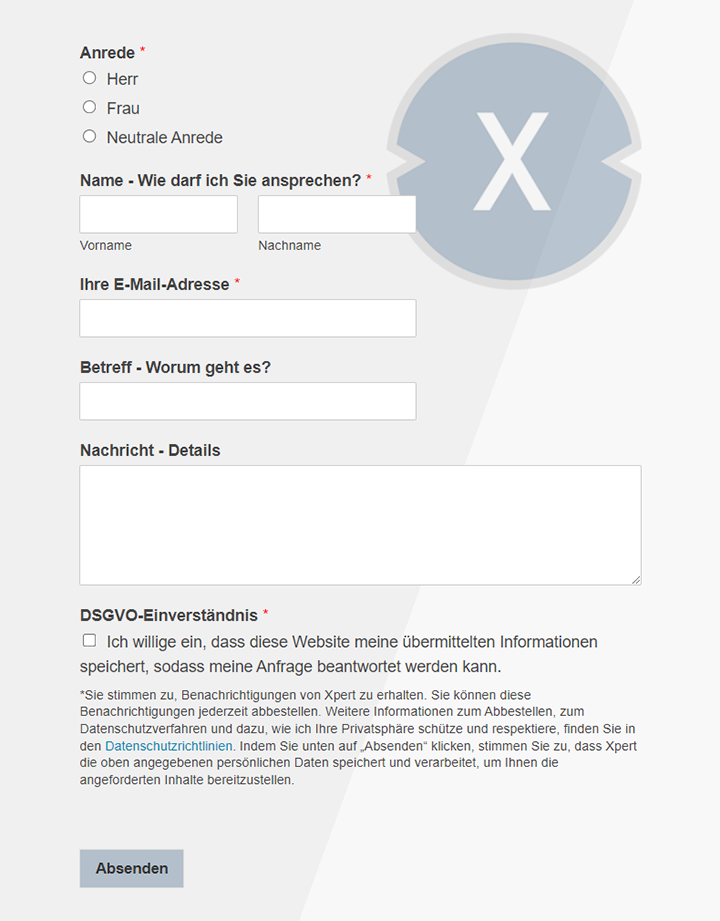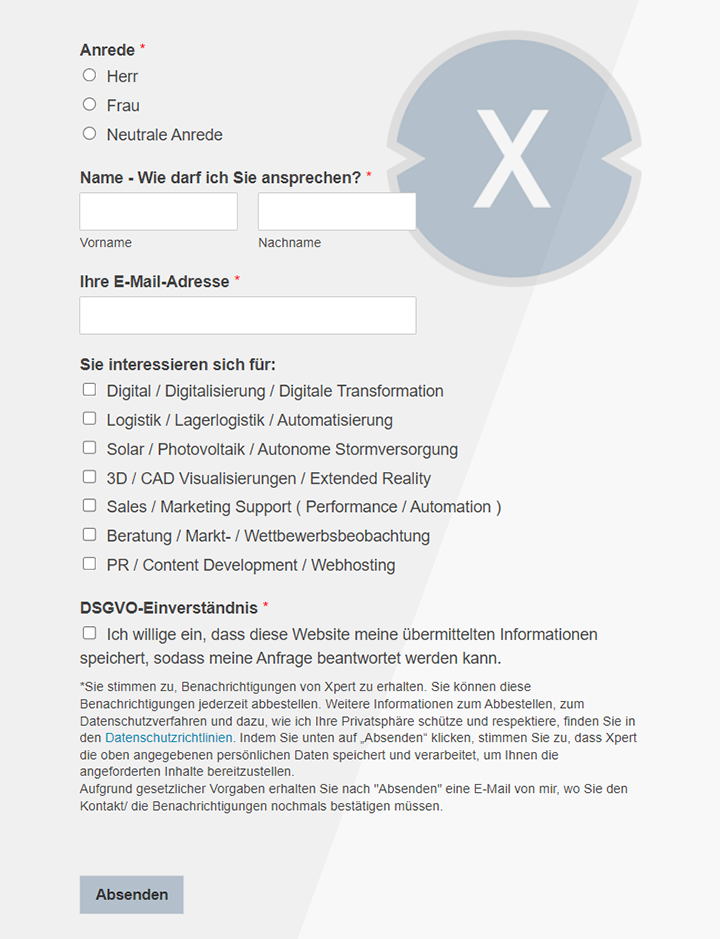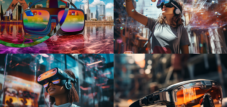The exciting development of video communication with zoom: Meta Quest enables virtual meetings with VR-AVATARE
Xpert pre-release
Language selection 📢
Published on: July 11, 2025 / update from: July 11, 2025 - Author: Konrad Wolfenstein

The exciting development of video communication with zoom: Meta Quest enables virtual meetings with VR-AVATARE-Image: Xpert.digital
Zoom brings virtual reality to the video conference: Meta Quest makes it possible
Virtual presence becomes real: Zoom app for Meta Quest is fundamentally changing video conferences-the next development step in the remote work
The way we communicate and work together has changed dramatically in recent years. What was once considered a futuristic vision today becomes tangible reality: With the new zoom app for Meta Quest, users can now take part in video conferences as virtual avatars. This development marks an important milestone in the evolution of digital communication and opens new dimensions for cooperation over distances.
Suitable for:
The new era of virtual presence
The integration of zoom into the Meta Quest ecosystem is a seamless expansion of the already known zoom workplace app, which use millions of people on their smartphones, tablets and desktop computers every day. However, the decisive difference lies in the type of presentation: Instead of a conventional video image, quest users appear as animated three-dimensional avatars in the meetings. This technology uses METAS's own avatar technology, which has been developed and refined for years.
The availability of this function extends over the entire spectrum of the Meta Quest product family. Both owners of the latest Quest 3 and Quest 3s as well as users of the older Quest 2 and the professional quest Pro can use the new zoom app. This broad compatibility ensures that a large user base gains access to this innovative form of communication.
Technical basics and functionality
Meta Quest 3 represents the current state of VR technology for consumers. With a weight of only 515 grams and equipped with the powerful Qualcomm Snapdragon XR2 Gen 2 processor, it offers an impressive technical basis. The two LCD displays with a resolution of 2,064 by 2,208 pixels per eye ensure a sharp and immersive visual experience. The horizontal field of view of 110 degrees and the vertical of 96 degrees create a natural feeling of presence in virtual environments.
A special feature of the Meta Quest 3 is the advanced passenthrough technology. Two RGB cameras with 4 megapixels each and a deep sensor make it possible to present the real environment in real time and in color on the displays. This function is particularly important for the new zoom app because it allows users to keep an eye on their physical environment during a meeting. The Passthrough resolution is ten times higher than in quest 2 and three times higher than in the Quest Pro, which ensures a significantly more realistic representation of the outside world.
The zoom app itself presents itself as an independent application, which no longer has to run through Metas Horizon Workrooms as before. This significantly simplifies access and makes use more intuitive. After downloading from the Meta Horizon Store and registration with the existing zoom account, users can immediately create or join meetings. The app appears as a window in the virtual environment, which enables multitasking and integrates seamlessly into the work flow.
Suitable for:
The development of the meta-avatars
The development of the meta-avatare is a history of continuous improvement and adaptation to user needs. The current avatars that are used in the zoom app represent a new generation of digital deputies. They are characterized by more sophisticated facial features, more realistic proportions and a greater variety of adaptation options. Users can choose from different facial shapes and finish individual parameters such as the jaw or chin size. Even details such as the angle of the ears can be adjusted.
The improved body presentation is particularly noteworthy. The new avatars make it possible to realistically present different body types, from slim to vigorous, with all intermediate stages. This inclusiveness ensures that more people can find themselves in their virtual representations. The avatars remain consciously in a comic style, which takes into account an important psychological aspect: they avoid the so-called uncanny Valley effect, in which too realistic but not perfect digital people are perceived as scary or repulsive.
The avatars are animated in real time and is based on the movements of the user. At the Meta Quest Pro, which has additional sensors for face and eye tracking, even facial expressions and viewing are transferred to the avatar. This ensures more natural and expressive communication. This technology is missing from the other quest models, which is why the avatars show less nuanced facial expressions. Nevertheless, all devices support hand tracking so that users can underline their controllers aside and with natural hand movements and gestures.
Advantages of virtual presence
The use of VR-Avatars in meetings has a number of advantages that go beyond the possibilities of conventional video conferences. A central aspect is the increased sense of presence. Participants often report that they feel more connected in VR meetings and more committed than in traditional video calls. The three -dimensional representation and the possibility of moving in a common virtual space create a closeness that cannot convey two -dimensional screens.
A practical advantage is the protection of privacy while at the same time personal presence. Not everyone wants or can be suitable for camera at any time. Perhaps you work in an untidy environment, just got a bad day or just don't want colleagues to get an insight into the private four walls. VR-Avatars offer an elegant solution here: you are present and actively involved in the meeting without having to worry about your own appearance or background.
Reduction of distractions is another important advantage. In an immersive VR environment, the usual interference factors of the home office-be it the smartphone, incoming emails or activities in the household. This leads to a higher concentration and more productive meetings. Studies show that productivity in virtual collaboration environments can be increased by up to 25 percent.
For companies with globally distributed teams, VR meetings open up new opportunities for cooperation. Time zone differences remain, but the quality of the interaction improves significantly. Teams can come together in virtual rooms that are specially designed for different types of meetings-from informal brainstorming room to formal conference room. The possibility of recording meetings and later experiencing in VR offers additional flexibility for team members who cannot be there live.
Suitable for:
- XR revolutionizes your life: from gaming to work 4.0 - like AR & VR logistics, production and meetings change
Challenges and limits
Despite all the advantages, VR meetings still face some challenges. The acquisition costs for VR headsets are still an important hurdle for many private individuals and companies. The META Quest 3 with a starting price of around 550 euros is significantly cheaper than professional VR solutions, but the costs quickly add up for the equipment of an entire team.
The technical requirements go beyond the pure hardware. A stable and fast internet connection is essential for liquid VR meetings. Delays or connections can significantly impair the experience and lead to frustration. In addition, the use of VR technology requires a certain familiarization period. Not all users immediately feel comfortable in the virtual environment, and some experience symptoms such as dizziness or nausea, which are known as motion Sickness.
The battery life of the headsets represents a further practical restriction. With about two to two and a half hours of useful life per load, longer meeting marathons are not possible without interruption. This requires careful planning and possibly investments in additional batteries or charging stations.
A particularly discussed aspect is the quality of the avatars compared to other systems. While Metas Comic-Avatars fulfill their purpose and avoid the Uncanny Valley effect, they seem significantly less realistic in a direct comparison with Apple's persona system on the Vision Pro. With its photo -realistic avatars, Apple has taken a different path that delivers more impressive visual results, but also plays in a completely different league with a price of $ 3,499.
The comparison with the competition
The development of VR-AVATARE and virtual meeting solutions is not a solo by Meta. Apple has presented a technologically impressive, albeit expensive counter-draft, with the Vision Pro and the persona system. Apple's personas are created by a scan of the face with the built -in cameras of the headset and offer a significantly more realistic representation. With the update to Visionos 26, these avatars have been significantly improved, with more detailed skin textures, more realistic hair and a complete side profile view.
The fundamental difference between the approaches lies in philosophy: While Meta relies on accessibility and broad availability, Apple aims at the highest possible quality. This is not only reflected in the price, but also in the technical implementation. Apple's system uses more advanced sensors and more computing power to achieve the photo -realistic results. However, Meta has already announced that it will work on its own photo-realistic codec-avatars that could close the gap to Apple in the future.
In addition to META and Apple, there are other providers of VR meeting solutions. Platforms such as meetings, spatial, Engage and Horizon workrooms each offer their own approaches and functions. MeetinVR, for example, focuses on business applications and offers specialized rooms for different meeting types. Spatial, on the other hand, makes it possible to bring any 3D content into virtual space, which is particularly interesting for creative and technical teams.
🗒️ Xpert.Digital: A pioneer in the field of extended and augmented reality
From product presentations to team building: These practical VR applications are fundamentally changing companies
Practical applications in the business world
The possible uses of VR meetings in the business world are diverse and go far beyond simple team meetings. Companies use the technology for virtual product presentations in which customers can experience new products in an immersive environment. The automobile manufacturer Volvo, for example, successfully used VR to present its XC90 model, with interested parties to take a seat in the vehicle and experience a test drive.
VR meetings open up new dimensions in the area of training and further education. Virtual training rooms enable complex processes and processes to convey realistic without having to be physically present. This is particularly valuable for companies with locations distributed globally or for training that would normally require expensive trips.
Creative teams use VR environments for brainstorming sessions and design reviews. The possibility of looking at three -dimensional objects together, manipulating and discussing, revolutionizes cooperation in areas such as architecture, product design and engineering. Designers can present their designs in their original size, and everyone involved can walk around the object and look at it from different perspectives.
VR meetings also find innovative applications in sales. Virtual showrooms make it impressive to present product portfolios without physical patterns to be sent. Customers can experience products in various configurations and environments, which leads to more informed purchase decisions.
Suitable for:
The social dimension of virtual encounters
An often underestimated aspect of VR meetings is their social component. In times of increasing remote work and spatial separation of teams, informal interactions play an important role in team cohesion. VR environments can partially close these gap by providing virtual break rooms, coffee kitchens or lounges in which colleagues can meet.
The opportunity to share shared experiences in VR creates new forms of team education. Virtual team building events, from escape rooms to playing together, promote cohesion and communication in a way that would not be possible in traditional video conferences. Companies report increased employee satisfaction and improved team dynamics through regular VR interactions.
VR can offer valuable support for onboarding, especially for new employees. Virtual office tours, meet-and-greets with colleagues and immersive introductions to corporate culture help to find their way faster and become part of the team, even if you are physically far away.
Data protection and ethical considerations
With the increasing use of VR technology for professional purposes, the focus is also on questions of data protection and ethics. The creation of avatars requires biometric data, even more detailed face scans for more advanced systems. Dealing with these sensitive information must be carefully regulated to prevent abuse.
Companies have to develop clear guidelines for the use of VR meetings that take into account both technical and social aspects. This includes questions such as: When is the use of VR appropriate and when is not? How is it ensured that all team members can participate equally, even if they have no access to VR technology? How are recordings of VR meetings handled and saved?
The question of digital exhaustion is also relevant. While VR meetings can offer more intensive experiences, they are also mentally and more demanding than traditional video conferences. Companies must make sure that the use of VR does not lead to additional stress, but actually offers added value.
view in the future
The integration of zoom in Meta Quest is only the beginning of a development that will fundamentally change our way of working and communicating. The technology is developing rapidly and several trends are already emerging.
The focus is on improving avatar technology. Meta is already working on photo-realistic codec avatars that will continue to blur the border between virtual and real presence. In the future, these could be so convincing that interlocutors can hardly distinguish whether they interact with a real person or an avatar.
The integration of artificial intelligence will make VR meetings even more efficient. AI-supported translations in real time could overcome language barriers, while intelligent assistants moderate meetings, create logs and coordinate follow-ups. The possibility of sending AI-generated avatars to meetings as representatives that can act and report independently is already being researched.
The hardware becomes continuously easier, more powerful and more affordable. Future headsets could be the size of normal glasses and still offer full VR functionality. The battery life will improve and wireless technologies will enable even more seamless experiences.
A particularly exciting aspect is the fusion of VR and AR (augmented reality) to mixed reality experiences. The META Quest 3 takes the first steps with its progressive passenthrough technology. In the future, meetings could take place in which some participants are physically present, while others appear in the room as holograms.
Social effects
The broad adoption of VR meetings will not only change the world of work, but also have social effects. The reduction of business trips contributes to reducing CO2 emissions and supports sustainability goals. Studies show that virtual meetings cause up to 99 percent fewer CO2 emissions than personal meetings by arrival.
The democratization of access to high -quality communication means can also reduce social inequalities. People in remote areas or with mobility restrictions get better opportunities for participation in business life. Small companies can communicate with global partners at eye level without having to apply high travel budgets.
However, we also have to keep an eye on the risks of an increasingly virtualized society. The loss of direct human interaction can have social and psychological consequences that are not yet fully understood. The balance between virtual and real presence will be one of the major challenges of the coming years.
Suitable for:
Practical tips to get you started
There are some practical considerations for companies and individuals who want to venture into VR meetings. First of all, it should be clarified which type of meetings would benefit the most from VR. Creative brainstorming, product presentations and team building events are particularly suitable, while routine status updates may not justify VR use.
Choosing the right hardware is crucial. While the META Quest 3 offers a good price-performance ratio, factors such as wearing comfort, battery life and available software should also be taken into account. It can make sense for companies to start with a pilot project and test the technology with a small group.
The introduction should be gradually carried out and accompanied by appropriate training. Not all employees will be enthusiastic, and it is important to take concerns seriously and offer alternatives. Hybrid meetings in which some participants use VR and take part in traditional paths can be a good temporary solution.
A new dimension of cooperation
The introduction of the Zoom app for Meta Quest marks an important milestone in the evolution of digital communication. VR meetings with avatars are no longer a distant vision of the future, but an available technology that can already be used today. Despite existing challenges, the potential predominates: more intensive cooperation, better work-life balance, reduced travel expenses and new creative opportunities.
The technology is still at the beginning of its development, and the coming years will be crucial for how VR meetings are established in the world of work. Improving avatar technology, the integration of AI and the development of lighter and more powerful hardware will make use even more attractive.
For companies and individuals who are investing in this technology today, there is an opportunity to be a pioneer in a new type of cooperation. The ability to effectively communicate and collaborate in virtual environments increasingly becomes an important competence in the digitized working world.
The vision of a future in which spatial distances no longer play a role in the quality of the collaboration is approaching. Meta Quest and the new zoom integration are important steps in this way. It is now up to us to use these technologies responsibly and to combine the best of both worlds - the virtual and real - in order to shape a more productive, more inclusive and sustainable future of work.
We are there for you - advice - planning - implementation - project management
☑️ SME support in strategy, consulting, planning and implementation
☑️ Creation or realignment of the digital strategy and digitalization
☑️ Expansion and optimization of international sales processes
☑️ Global & Digital B2B trading platforms
☑️ Pioneer Business Development
I would be happy to serve as your personal advisor.
You can contact me by filling out the contact form below or simply call me on +49 89 89 674 804 (Munich) .
I'm looking forward to our joint project.
Xpert.Digital - Konrad Wolfenstein
Xpert.Digital is a hub for industry with a focus on digitalization, mechanical engineering, logistics/intralogistics and photovoltaics.
With our 360° business development solution, we support well-known companies from new business to after sales.
Market intelligence, smarketing, marketing automation, content development, PR, mail campaigns, personalized social media and lead nurturing are part of our digital tools.
You can find out more at: www.xpert.digital - www.xpert.solar - www.xpert.plus





























